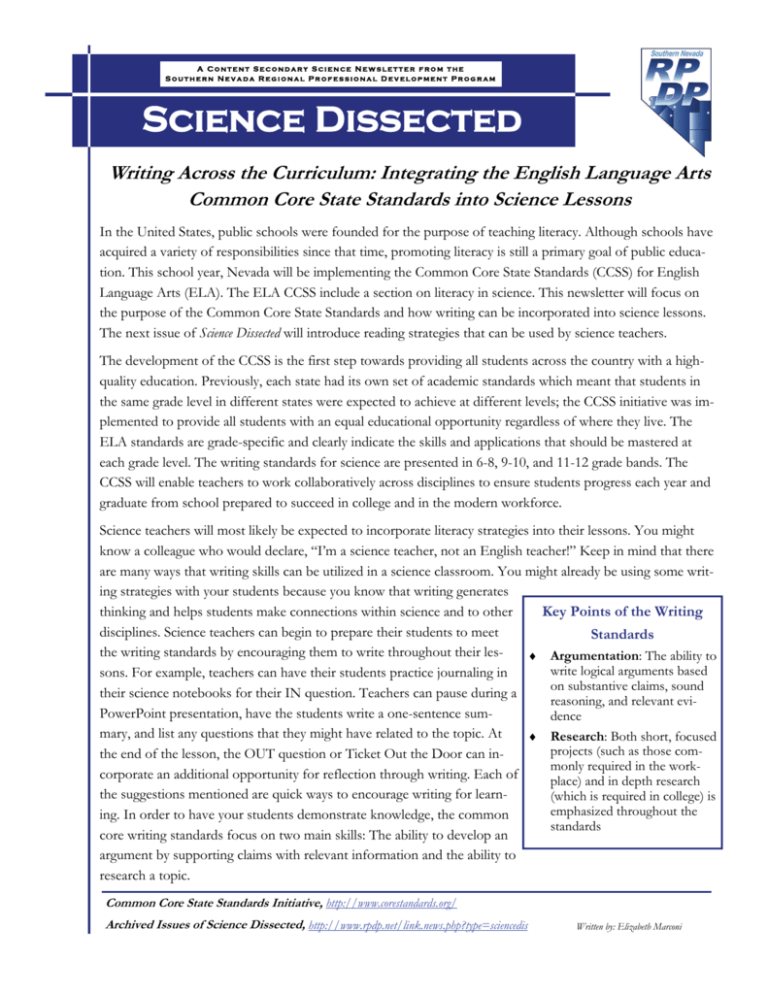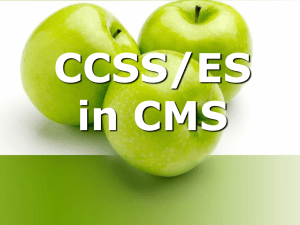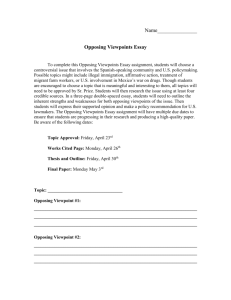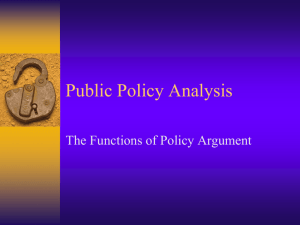1. Integrating ELA CCSS Writing into Science Lessons
advertisement

A Content Secondary Science Newsletter from the Southern Nevada Regional Professional Development Program Science Dissected Writing Across the Curriculum: Integrating the English Language Arts Common Core State Standards into Science Lessons In the United States, public schools were founded for the purpose of teaching literacy. Although schools have acquired a variety of responsibilities since that time, promoting literacy is still a primary goal of public education. This school year, Nevada will be implementing the Common Core State Standards (CCSS) for English Language Arts (ELA). The ELA CCSS include a section on literacy in science. This newsletter will focus on the purpose of the Common Core State Standards and how writing can be incorporated into science lessons. The next issue of Science Dissected will introduce reading strategies that can be used by science teachers. The development of the CCSS is the first step towards providing all students across the country with a highquality education. Previously, each state had its own set of academic standards which meant that students in the same grade level in different states were expected to achieve at different levels; the CCSS initiative was implemented to provide all students with an equal educational opportunity regardless of where they live. The ELA standards are grade-specific and clearly indicate the skills and applications that should be mastered at each grade level. The writing standards for science are presented in 6-8, 9-10, and 11-12 grade bands. The CCSS will enable teachers to work collaboratively across disciplines to ensure students progress each year and graduate from school prepared to succeed in college and in the modern workforce. Science teachers will most likely be expected to incorporate literacy strategies into their lessons. You might know a colleague who would declare, “I’m a science teacher, not an English teacher!” Keep in mind that there are many ways that writing skills can be utilized in a science classroom. You might already be using some writing strategies with your students because you know that writing generates Key Points of the Writing thinking and helps students make connections within science and to other disciplines. Science teachers can begin to prepare their students to meet Standards the writing standards by encouraging them to write throughout their les Argumentation: The ability to write logical arguments based sons. For example, teachers can have their students practice journaling in on substantive claims, sound their science notebooks for their IN question. Teachers can pause during a reasoning, and relevant eviPowerPoint presentation, have the students write a one-sentence sumdence mary, and list any questions that they might have related to the topic. At Research: Both short, focused projects (such as those comthe end of the lesson, the OUT question or Ticket Out the Door can inmonly required in the workcorporate an additional opportunity for reflection through writing. Each of place) and in depth research the suggestions mentioned are quick ways to encourage writing for learn(which is required in college) is emphasized throughout the ing. In order to have your students demonstrate knowledge, the common standards core writing standards focus on two main skills: The ability to develop an argument by supporting claims with relevant information and the ability to research a topic. Common Core State Standards Initiative, http://www.corestandards.org/ Archived Issues of Science Dissected, http://www.rpdp.net/link.news.php?type=sciencedis Written by: Elizabeth Marconi Page 2 Writing Across the Curriculum: Integrating the English Language Arts Common Core State Standards into Science Lessons continued... Teachers can encourage their students to conduct research by assigning creative projects that require background information such as designing a brochure, producing a video public service announcement, or creating a PowerPoint to explain a topic. Teachers can also have their students complete a standard research paper each semester. The concept of argumentation can be introduced by requiring students to write conclusions to their lab reports that include a claim which is supported by evidence. For example, a student can describe the reason for developing her hypothesis and explain why the data that she collected does or does not support the expected results. Once students are introduced to the concept, teachers can expand the assignment and have their students write arguments focused on discipline-specific content. Argumentation requires students to take a position on a topic that has more than one viewpoint and persuade the reader, by using a warrant, that the evidence presented and data cited are strong enough to support their claim. The topic does not need to be controversial to constitute an argument. A sound argument states a claim and supports it with evidence in a clear and logical manner. It is important to clarify that scientific argumentation is not a summarization of a topic. Argumentation requires students to arrive at conclusions through a process of logical reasoning. While developing an argument, students should mention opposing viewpoints and then refute them with counterarguments. Teachers can assist their students with writing arguments by providing the following graphic organizers as a prewriting strategy. Argumentation requires students to “take a side” or “make a point.” Therefore, students should not start by summarizing information. Teachers should encourage students to brainstorm a list of arguments related to the claim. Students then complete the graphic organizer on the right by listing the possible arguments, opposing viewpoints, and writing counterarguments to the opposing viewpoints. Once the students have the information listed in the graphic organizer, then they can make the transition to writing the information in a basic four-part paragraph. Important Definitions: Claim– The position or thesis Evidence– The data or supporting information that reinforce the claim Warrant– Inferential leap that connects the claim and the evidence Graphic Organizer for Elements of an Argument Argumentation Claim: Position For Opposing Viewpoints Argument #1: Opposing Viewpoint #1: Counterargument #1: Argument #2: Counterargument #2: Opposing Viewpoint #2: Basic Four-Part Structure Assertion Concession Rebuttal Conclusion State the claim Explain Opposing Viewpoint Explain the Counterargument Summarize the Argument Resources Available Appendix C of the CCSS contains annotated samples of student writing to help teachers establish adequate performance levels in writing arguments, informational/explanatory texts, and narratives in the various grades. Click here for Appendix C. The ELA Common Core State Standards are available at: www.corestandards.org/







